ECPI MET230L: Hydraulics and Pneumatics Unit 2 Lab Assignment 2
VerifiedAdded on 2022/12/14
|12
|1835
|426
Practical Assignment
AI Summary
This document presents a comprehensive solution to the MET230L: Hydraulics and Pneumatics Lab Unit 2 Lab Assignment 2. The assignment focuses on simulating various pneumatic circuits using specialized software. The solutions detail the functionality of different components, including double-acting and single-acting cylinders, valves with different actuation methods (push buttons, roller levers, proximity switches, and pressure sequence valves), and flow control valves. Each exercise explores a specific circuit configuration, such as the pneumatic seal-in (latch) function, and requires the student to analyze the cylinder's behavior under different conditions. The document includes detailed explanations of each circuit's operation, answers to specific questions about the cylinder's movements, and screenshots of the simulated circuits. The assignment covers topics such as how valves control the cylinder's extension and retraction, the impact of flow control valves on cylinder speed, and the use of different valve types to achieve specific control functions. The student is also asked to describe the function of different components. The document provides a complete solution to the assignment, demonstrating the practical application of pneumatic principles in circuit design and control.
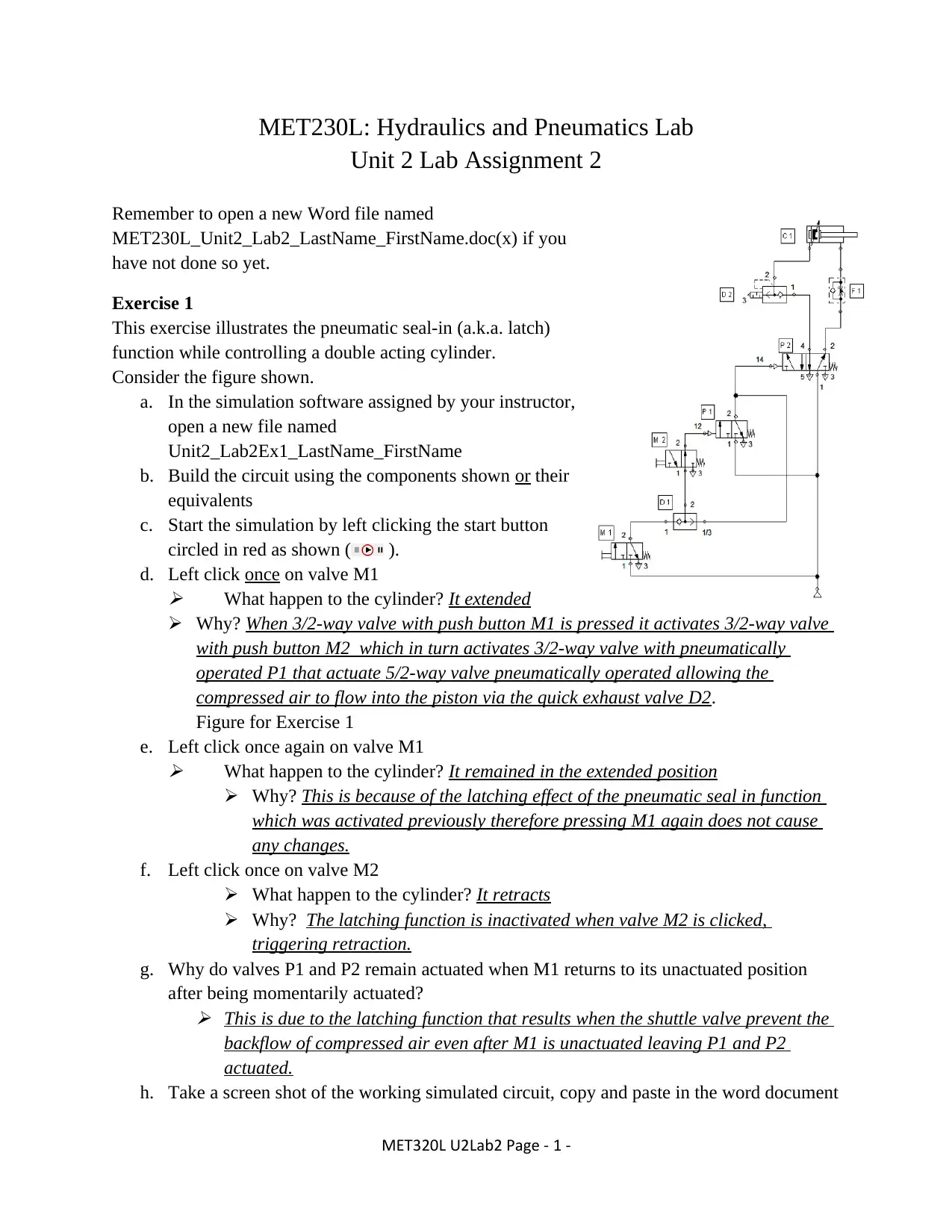
MET230L: Hydraulics and Pneumatics Lab
Unit 2 Lab Assignment 2
Remember to open a new Word file named
MET230L_Unit2_Lab2_LastName_FirstName.doc(x) if you
have not done so yet.
Exercise 1
This exercise illustrates the pneumatic seal-in (a.k.a. latch)
function while controlling a double acting cylinder.
Consider the figure shown.
a. In the simulation software assigned by your instructor,
open a new file named
Unit2_Lab2Ex1_LastName_FirstName
b. Build the circuit using the components shown or their
equivalents
c. Start the simulation by left clicking the start button
circled in red as shown ( ).
d. Left click once on valve M1
What happen to the cylinder? It extended
Why? When 3/2-way valve with push button M1 is pressed it activates 3/2-way valve
with push button M2 which in turn activates 3/2-way valve with pneumatically
operated P1 that actuate 5/2-way valve pneumatically operated allowing the
compressed air to flow into the piston via the quick exhaust valve D2.
Figure for Exercise 1
e. Left click once again on valve M1
What happen to the cylinder? It remained in the extended position
Why? This is because of the latching effect of the pneumatic seal in function
which was activated previously therefore pressing M1 again does not cause
any changes.
f. Left click once on valve M2
What happen to the cylinder? It retracts
Why? The latching function is inactivated when valve M2 is clicked,
triggering retraction.
g. Why do valves P1 and P2 remain actuated when M1 returns to its unactuated position
after being momentarily actuated?
This is due to the latching function that results when the shuttle valve prevent the
backflow of compressed air even after M1 is unactuated leaving P1 and P2
actuated.
h. Take a screen shot of the working simulated circuit, copy and paste in the word document
MET320L U2Lab2 Page - 1 -
Unit 2 Lab Assignment 2
Remember to open a new Word file named
MET230L_Unit2_Lab2_LastName_FirstName.doc(x) if you
have not done so yet.
Exercise 1
This exercise illustrates the pneumatic seal-in (a.k.a. latch)
function while controlling a double acting cylinder.
Consider the figure shown.
a. In the simulation software assigned by your instructor,
open a new file named
Unit2_Lab2Ex1_LastName_FirstName
b. Build the circuit using the components shown or their
equivalents
c. Start the simulation by left clicking the start button
circled in red as shown ( ).
d. Left click once on valve M1
What happen to the cylinder? It extended
Why? When 3/2-way valve with push button M1 is pressed it activates 3/2-way valve
with push button M2 which in turn activates 3/2-way valve with pneumatically
operated P1 that actuate 5/2-way valve pneumatically operated allowing the
compressed air to flow into the piston via the quick exhaust valve D2.
Figure for Exercise 1
e. Left click once again on valve M1
What happen to the cylinder? It remained in the extended position
Why? This is because of the latching effect of the pneumatic seal in function
which was activated previously therefore pressing M1 again does not cause
any changes.
f. Left click once on valve M2
What happen to the cylinder? It retracts
Why? The latching function is inactivated when valve M2 is clicked,
triggering retraction.
g. Why do valves P1 and P2 remain actuated when M1 returns to its unactuated position
after being momentarily actuated?
This is due to the latching function that results when the shuttle valve prevent the
backflow of compressed air even after M1 is unactuated leaving P1 and P2
actuated.
h. Take a screen shot of the working simulated circuit, copy and paste in the word document
MET320L U2Lab2 Page - 1 -
Paraphrase This Document
Need a fresh take? Get an instant paraphrase of this document with our AI Paraphraser
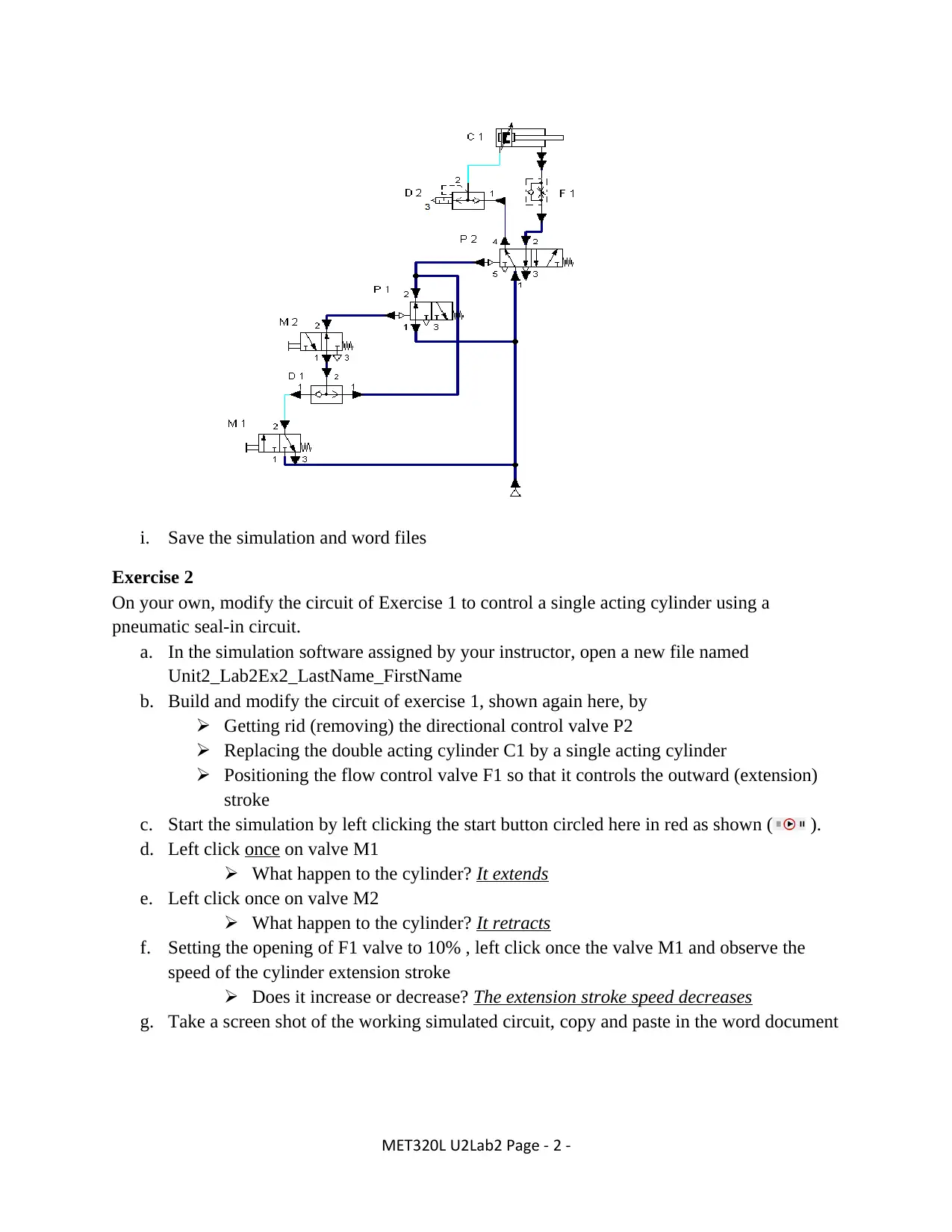
i. Save the simulation and word files
Exercise 2
On your own, modify the circuit of Exercise 1 to control a single acting cylinder using a
pneumatic seal-in circuit.
a. In the simulation software assigned by your instructor, open a new file named
Unit2_Lab2Ex2_LastName_FirstName
b. Build and modify the circuit of exercise 1, shown again here, by
Getting rid (removing) the directional control valve P2
Replacing the double acting cylinder C1 by a single acting cylinder
Positioning the flow control valve F1 so that it controls the outward (extension)
stroke
c. Start the simulation by left clicking the start button circled here in red as shown ( ).
d. Left click once on valve M1
What happen to the cylinder? It extends
e. Left click once on valve M2
What happen to the cylinder? It retracts
f. Setting the opening of F1 valve to 10% , left click once the valve M1 and observe the
speed of the cylinder extension stroke
Does it increase or decrease? The extension stroke speed decreases
g. Take a screen shot of the working simulated circuit, copy and paste in the word document
MET320L U2Lab2 Page - 2 -
Exercise 2
On your own, modify the circuit of Exercise 1 to control a single acting cylinder using a
pneumatic seal-in circuit.
a. In the simulation software assigned by your instructor, open a new file named
Unit2_Lab2Ex2_LastName_FirstName
b. Build and modify the circuit of exercise 1, shown again here, by
Getting rid (removing) the directional control valve P2
Replacing the double acting cylinder C1 by a single acting cylinder
Positioning the flow control valve F1 so that it controls the outward (extension)
stroke
c. Start the simulation by left clicking the start button circled here in red as shown ( ).
d. Left click once on valve M1
What happen to the cylinder? It extends
e. Left click once on valve M2
What happen to the cylinder? It retracts
f. Setting the opening of F1 valve to 10% , left click once the valve M1 and observe the
speed of the cylinder extension stroke
Does it increase or decrease? The extension stroke speed decreases
g. Take a screen shot of the working simulated circuit, copy and paste in the word document
MET320L U2Lab2 Page - 2 -
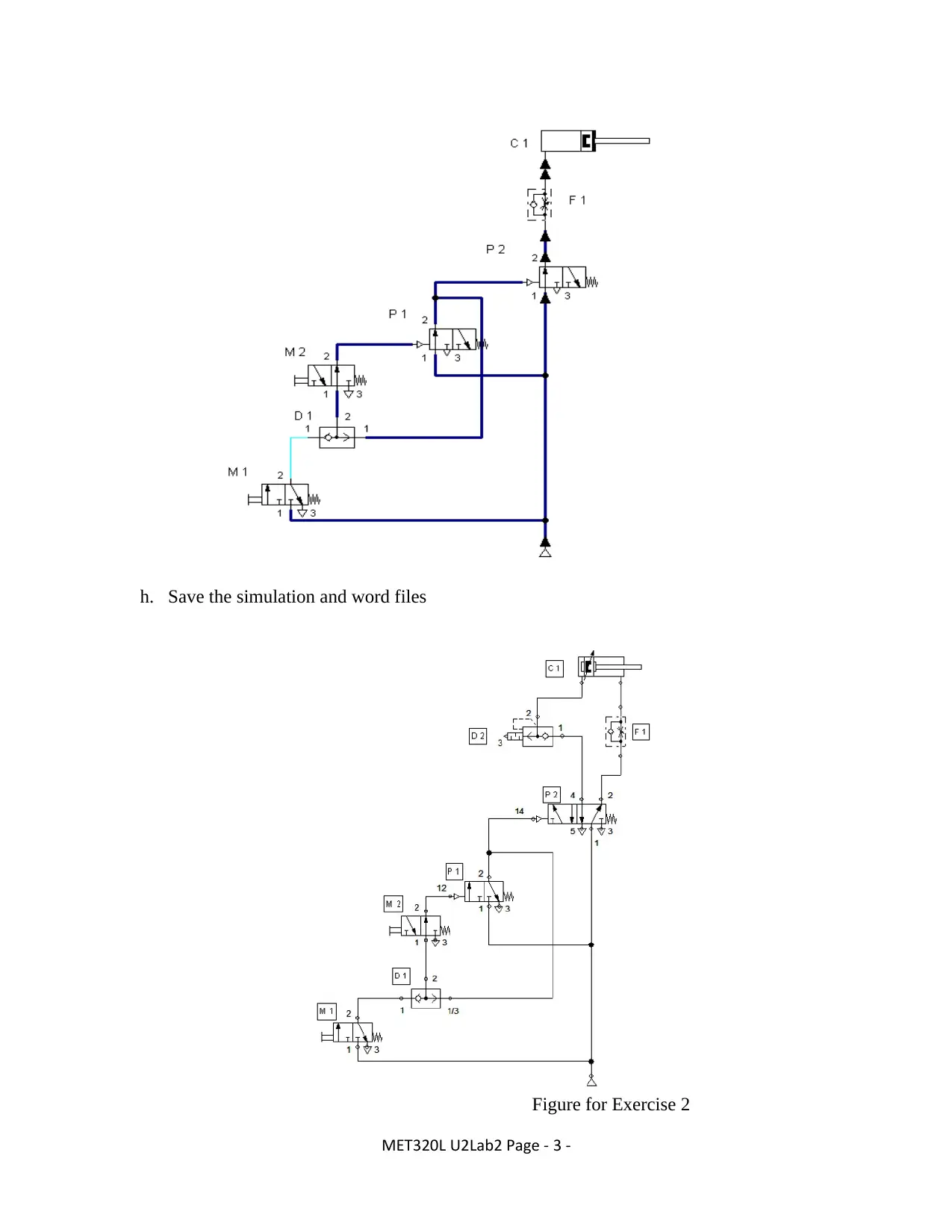
h. Save the simulation and word files
Figure for Exercise 2
MET320L U2Lab2 Page - 3 -
Figure for Exercise 2
MET320L U2Lab2 Page - 3 -
⊘ This is a preview!⊘
Do you want full access?
Subscribe today to unlock all pages.

Trusted by 1+ million students worldwide

Exercise 3
Consider the figure shown.
a. Give the complete name of the component M3. This should include its mode of actuation.
3/2-way idle return roller valve
b. In less than three line, briefly describe how it (M3) works
It is actuated when the roller lever is traversed by the cam of a cylinder in a certain
direction and after release of the roller lever, the valve is returned to its initial position
by a return spring. (Festo, 2019)
c. In the simulation software assigned by your instructor, open a new file named
Unit2_Lab2Ex3_LastName_FirstName
d. Build the circuit using the components shown or their equivalents
e. Start the simulation by left clicking the start button circled here in red as shown ( ).
f. Set the opening of valve F1 and valve F2 to 10%
g. Left click once on valve M1
What happens to the cylinder rod? It extends
h. Left click once on valve M2
What happen to the cylinder rod? It retracts
i. Left click once again on valve M1 and as the rod still extends, left click on valve M2
What happens to the cylinder rod? It retracts immediately.
Why? On clicking M2 it unactuate P1 instantly leading to immediate
retraction.
j. Looking to the diagram, what are the two valves that need to be simultaneously actuated
for the rod to start extending?
Valve M3 and valve P1
k. Take a screen shot of the working simulated circuit, copy and paste in the word document
MET320L U2Lab2 Page - 4 -
Consider the figure shown.
a. Give the complete name of the component M3. This should include its mode of actuation.
3/2-way idle return roller valve
b. In less than three line, briefly describe how it (M3) works
It is actuated when the roller lever is traversed by the cam of a cylinder in a certain
direction and after release of the roller lever, the valve is returned to its initial position
by a return spring. (Festo, 2019)
c. In the simulation software assigned by your instructor, open a new file named
Unit2_Lab2Ex3_LastName_FirstName
d. Build the circuit using the components shown or their equivalents
e. Start the simulation by left clicking the start button circled here in red as shown ( ).
f. Set the opening of valve F1 and valve F2 to 10%
g. Left click once on valve M1
What happens to the cylinder rod? It extends
h. Left click once on valve M2
What happen to the cylinder rod? It retracts
i. Left click once again on valve M1 and as the rod still extends, left click on valve M2
What happens to the cylinder rod? It retracts immediately.
Why? On clicking M2 it unactuate P1 instantly leading to immediate
retraction.
j. Looking to the diagram, what are the two valves that need to be simultaneously actuated
for the rod to start extending?
Valve M3 and valve P1
k. Take a screen shot of the working simulated circuit, copy and paste in the word document
MET320L U2Lab2 Page - 4 -
Paraphrase This Document
Need a fresh take? Get an instant paraphrase of this document with our AI Paraphraser
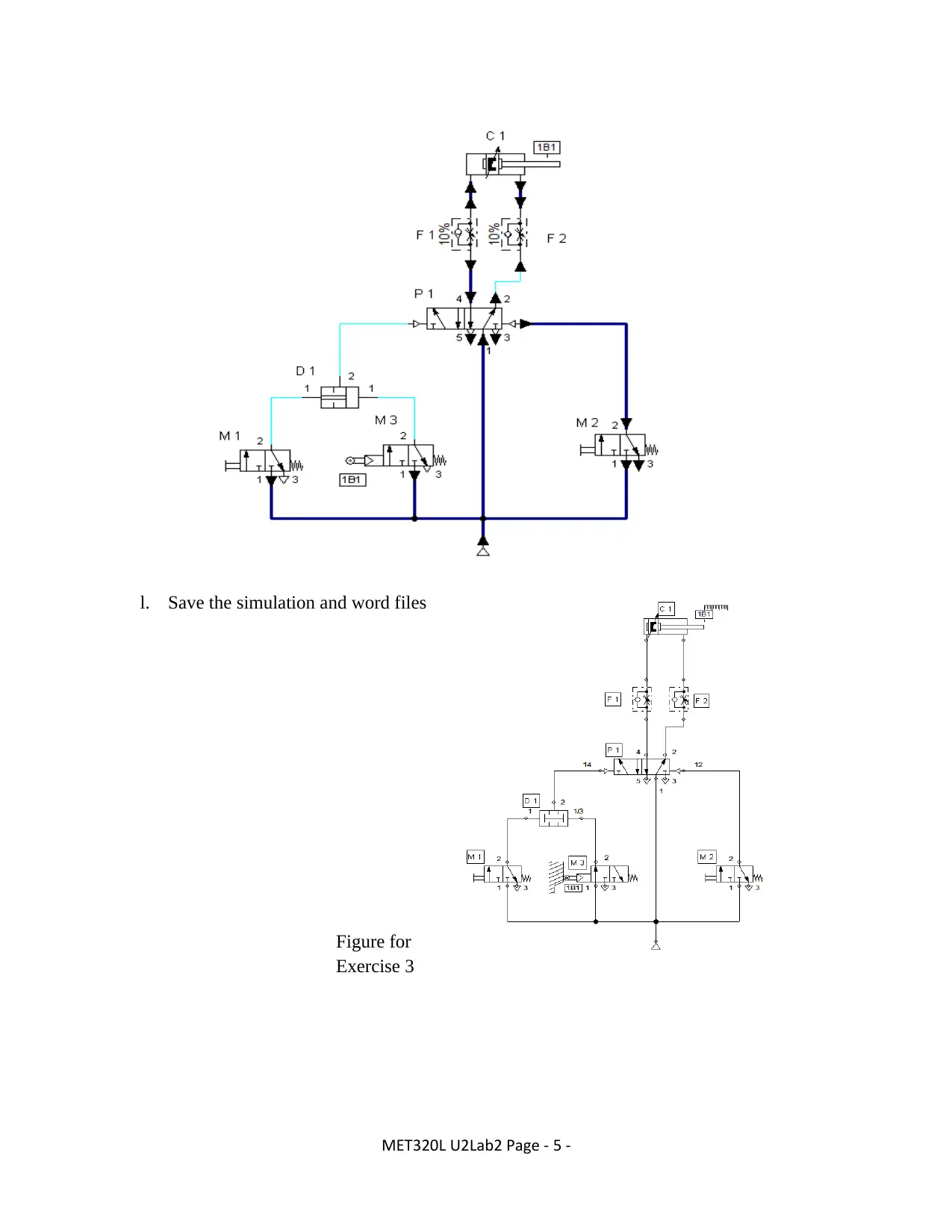
l. Save the simulation and word files
Figure for
Exercise 3
MET320L U2Lab2 Page - 5 -
Figure for
Exercise 3
MET320L U2Lab2 Page - 5 -
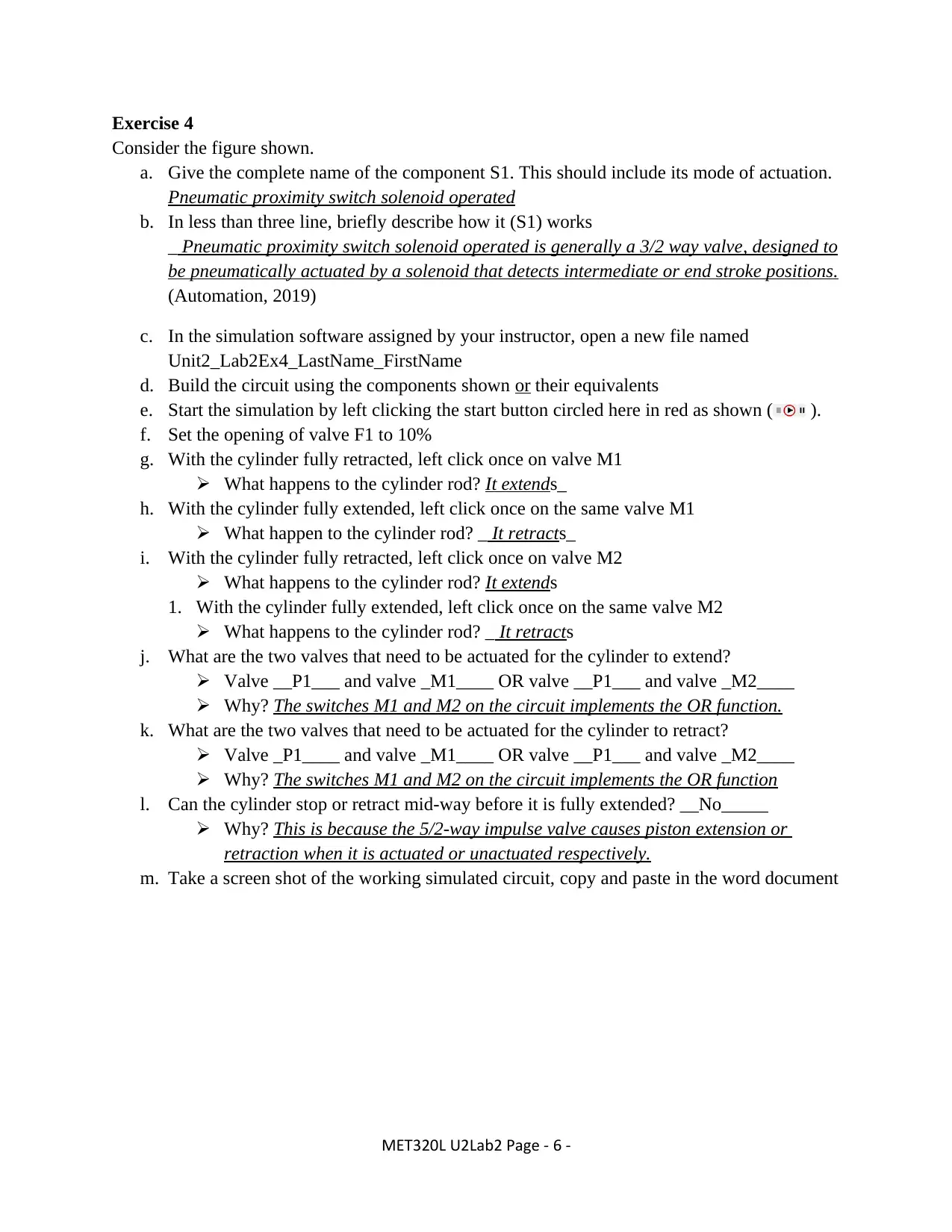
Exercise 4
Consider the figure shown.
a. Give the complete name of the component S1. This should include its mode of actuation.
Pneumatic proximity switch solenoid operated
b. In less than three line, briefly describe how it (S1) works
_ Pneumatic proximity switch solenoid operated is generally a 3/2 way valve, designed to
be pneumatically actuated by a solenoid that detects intermediate or end stroke positions.
(Automation, 2019)
c. In the simulation software assigned by your instructor, open a new file named
Unit2_Lab2Ex4_LastName_FirstName
d. Build the circuit using the components shown or their equivalents
e. Start the simulation by left clicking the start button circled here in red as shown ( ).
f. Set the opening of valve F1 to 10%
g. With the cylinder fully retracted, left click once on valve M1
What happens to the cylinder rod? It extends_
h. With the cylinder fully extended, left click once on the same valve M1
What happen to the cylinder rod? _ It retracts_
i. With the cylinder fully retracted, left click once on valve M2
What happens to the cylinder rod? It extends
1. With the cylinder fully extended, left click once on the same valve M2
What happens to the cylinder rod? _ It retracts
j. What are the two valves that need to be actuated for the cylinder to extend?
Valve __P1___ and valve _M1____ OR valve __P1___ and valve _M2____
Why? The switches M1 and M2 on the circuit implements the OR function.
k. What are the two valves that need to be actuated for the cylinder to retract?
Valve _P1____ and valve _M1____ OR valve __P1___ and valve _M2____
Why? The switches M1 and M2 on the circuit implements the OR function
l. Can the cylinder stop or retract mid-way before it is fully extended? __No_____
Why? This is because the 5/2-way impulse valve causes piston extension or
retraction when it is actuated or unactuated respectively.
m. Take a screen shot of the working simulated circuit, copy and paste in the word document
MET320L U2Lab2 Page - 6 -
Consider the figure shown.
a. Give the complete name of the component S1. This should include its mode of actuation.
Pneumatic proximity switch solenoid operated
b. In less than three line, briefly describe how it (S1) works
_ Pneumatic proximity switch solenoid operated is generally a 3/2 way valve, designed to
be pneumatically actuated by a solenoid that detects intermediate or end stroke positions.
(Automation, 2019)
c. In the simulation software assigned by your instructor, open a new file named
Unit2_Lab2Ex4_LastName_FirstName
d. Build the circuit using the components shown or their equivalents
e. Start the simulation by left clicking the start button circled here in red as shown ( ).
f. Set the opening of valve F1 to 10%
g. With the cylinder fully retracted, left click once on valve M1
What happens to the cylinder rod? It extends_
h. With the cylinder fully extended, left click once on the same valve M1
What happen to the cylinder rod? _ It retracts_
i. With the cylinder fully retracted, left click once on valve M2
What happens to the cylinder rod? It extends
1. With the cylinder fully extended, left click once on the same valve M2
What happens to the cylinder rod? _ It retracts
j. What are the two valves that need to be actuated for the cylinder to extend?
Valve __P1___ and valve _M1____ OR valve __P1___ and valve _M2____
Why? The switches M1 and M2 on the circuit implements the OR function.
k. What are the two valves that need to be actuated for the cylinder to retract?
Valve _P1____ and valve _M1____ OR valve __P1___ and valve _M2____
Why? The switches M1 and M2 on the circuit implements the OR function
l. Can the cylinder stop or retract mid-way before it is fully extended? __No_____
Why? This is because the 5/2-way impulse valve causes piston extension or
retraction when it is actuated or unactuated respectively.
m. Take a screen shot of the working simulated circuit, copy and paste in the word document
MET320L U2Lab2 Page - 6 -
⊘ This is a preview!⊘
Do you want full access?
Subscribe today to unlock all pages.

Trusted by 1+ million students worldwide
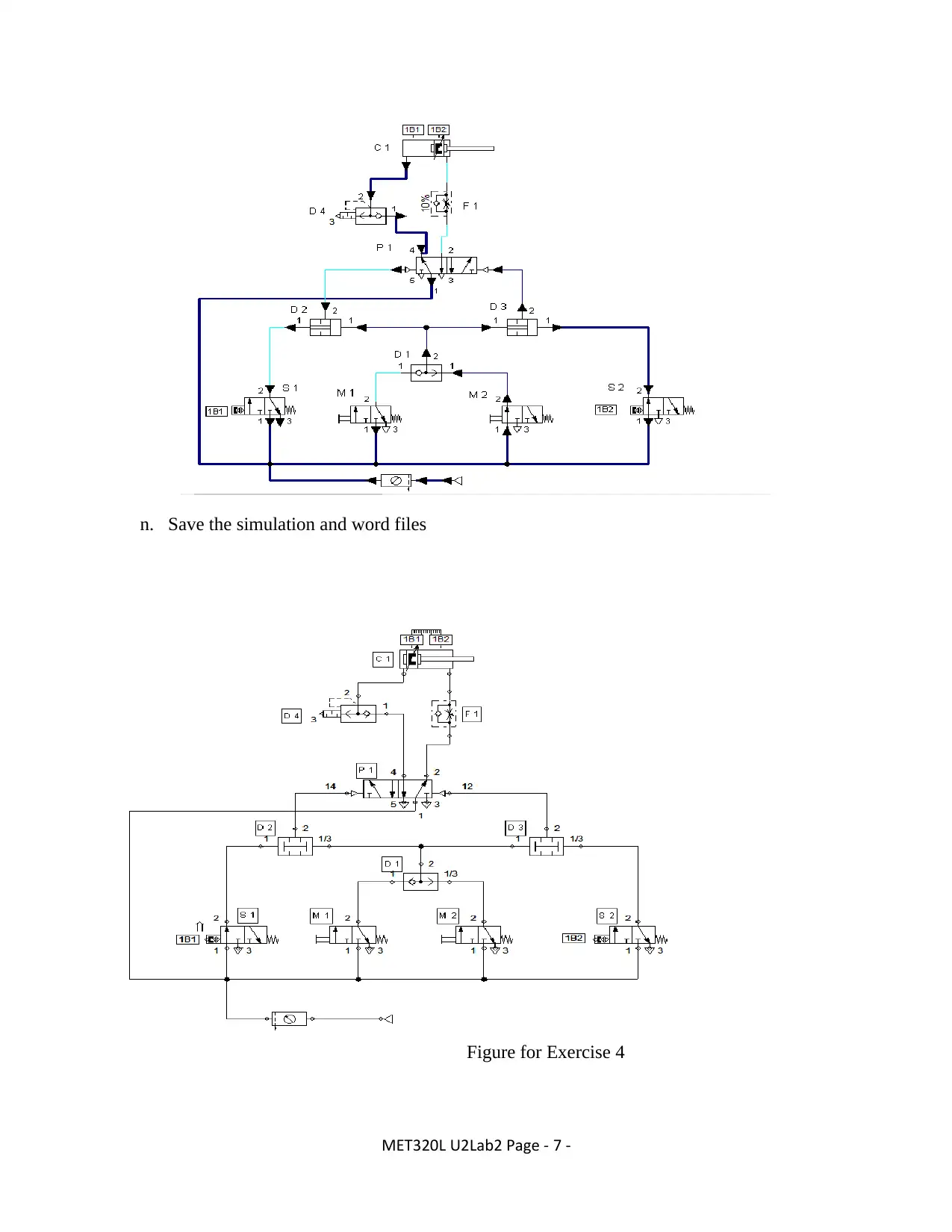
n. Save the simulation and word files
Figure for Exercise 4
MET320L U2Lab2 Page - 7 -
Figure for Exercise 4
MET320L U2Lab2 Page - 7 -
Paraphrase This Document
Need a fresh take? Get an instant paraphrase of this document with our AI Paraphraser
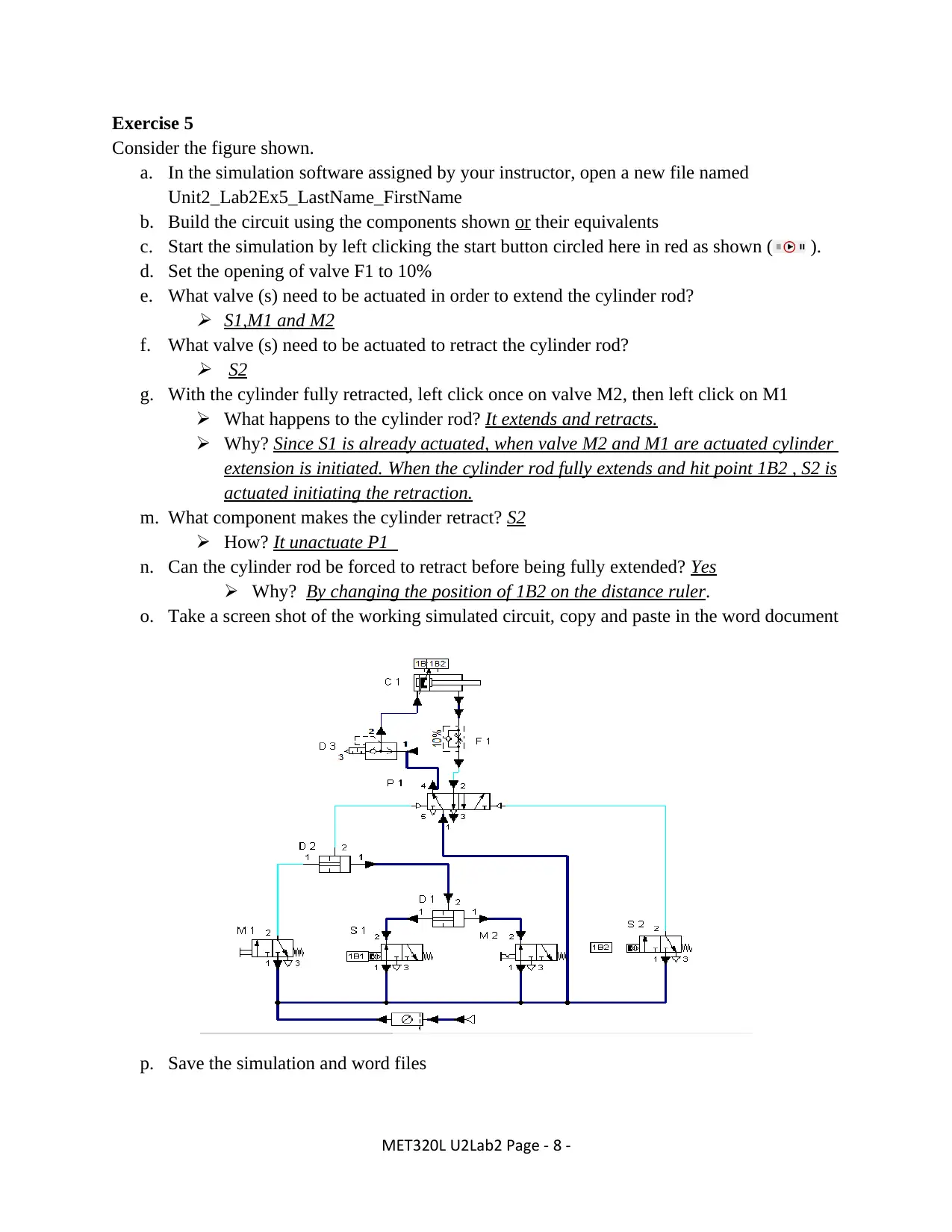
Exercise 5
Consider the figure shown.
a. In the simulation software assigned by your instructor, open a new file named
Unit2_Lab2Ex5_LastName_FirstName
b. Build the circuit using the components shown or their equivalents
c. Start the simulation by left clicking the start button circled here in red as shown ( ).
d. Set the opening of valve F1 to 10%
e. What valve (s) need to be actuated in order to extend the cylinder rod?
S1,M1 and M2
f. What valve (s) need to be actuated to retract the cylinder rod?
S2
g. With the cylinder fully retracted, left click once on valve M2, then left click on M1
What happens to the cylinder rod? It extends and retracts.
Why? Since S1 is already actuated, when valve M2 and M1 are actuated cylinder
extension is initiated. When the cylinder rod fully extends and hit point 1B2 , S2 is
actuated initiating the retraction.
m. What component makes the cylinder retract? S2
How? It unactuate P1_
n. Can the cylinder rod be forced to retract before being fully extended? Yes
Why? By changing the position of 1B2 on the distance ruler.
o. Take a screen shot of the working simulated circuit, copy and paste in the word document
p. Save the simulation and word files
MET320L U2Lab2 Page - 8 -
Consider the figure shown.
a. In the simulation software assigned by your instructor, open a new file named
Unit2_Lab2Ex5_LastName_FirstName
b. Build the circuit using the components shown or their equivalents
c. Start the simulation by left clicking the start button circled here in red as shown ( ).
d. Set the opening of valve F1 to 10%
e. What valve (s) need to be actuated in order to extend the cylinder rod?
S1,M1 and M2
f. What valve (s) need to be actuated to retract the cylinder rod?
S2
g. With the cylinder fully retracted, left click once on valve M2, then left click on M1
What happens to the cylinder rod? It extends and retracts.
Why? Since S1 is already actuated, when valve M2 and M1 are actuated cylinder
extension is initiated. When the cylinder rod fully extends and hit point 1B2 , S2 is
actuated initiating the retraction.
m. What component makes the cylinder retract? S2
How? It unactuate P1_
n. Can the cylinder rod be forced to retract before being fully extended? Yes
Why? By changing the position of 1B2 on the distance ruler.
o. Take a screen shot of the working simulated circuit, copy and paste in the word document
p. Save the simulation and word files
MET320L U2Lab2 Page - 8 -
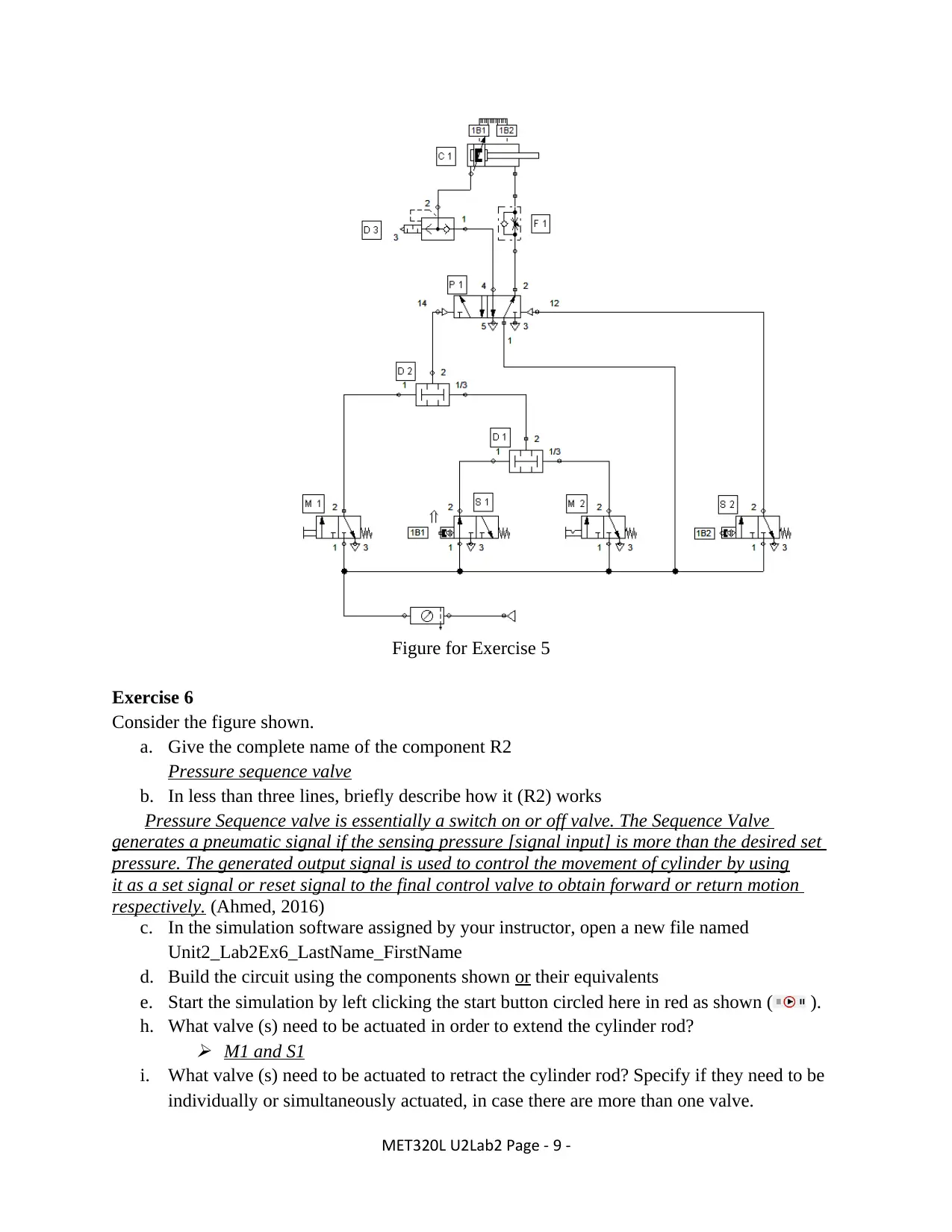
Figure for Exercise 5
Exercise 6
Consider the figure shown.
a. Give the complete name of the component R2
Pressure sequence valve
b. In less than three lines, briefly describe how it (R2) works
Pressure Sequence valve is essentially a switch on or off valve. The Sequence Valve
generates a pneumatic signal if the sensing pressure [signal input] is more than the desired set
pressure. The generated output signal is used to control the movement of cylinder by using
it as a set signal or reset signal to the final control valve to obtain forward or return motion
respectively. (Ahmed, 2016)
c. In the simulation software assigned by your instructor, open a new file named
Unit2_Lab2Ex6_LastName_FirstName
d. Build the circuit using the components shown or their equivalents
e. Start the simulation by left clicking the start button circled here in red as shown ( ).
h. What valve (s) need to be actuated in order to extend the cylinder rod?
M1 and S1
i. What valve (s) need to be actuated to retract the cylinder rod? Specify if they need to be
individually or simultaneously actuated, in case there are more than one valve.
MET320L U2Lab2 Page - 9 -
Exercise 6
Consider the figure shown.
a. Give the complete name of the component R2
Pressure sequence valve
b. In less than three lines, briefly describe how it (R2) works
Pressure Sequence valve is essentially a switch on or off valve. The Sequence Valve
generates a pneumatic signal if the sensing pressure [signal input] is more than the desired set
pressure. The generated output signal is used to control the movement of cylinder by using
it as a set signal or reset signal to the final control valve to obtain forward or return motion
respectively. (Ahmed, 2016)
c. In the simulation software assigned by your instructor, open a new file named
Unit2_Lab2Ex6_LastName_FirstName
d. Build the circuit using the components shown or their equivalents
e. Start the simulation by left clicking the start button circled here in red as shown ( ).
h. What valve (s) need to be actuated in order to extend the cylinder rod?
M1 and S1
i. What valve (s) need to be actuated to retract the cylinder rod? Specify if they need to be
individually or simultaneously actuated, in case there are more than one valve.
MET320L U2Lab2 Page - 9 -
⊘ This is a preview!⊘
Do you want full access?
Subscribe today to unlock all pages.

Trusted by 1+ million students worldwide
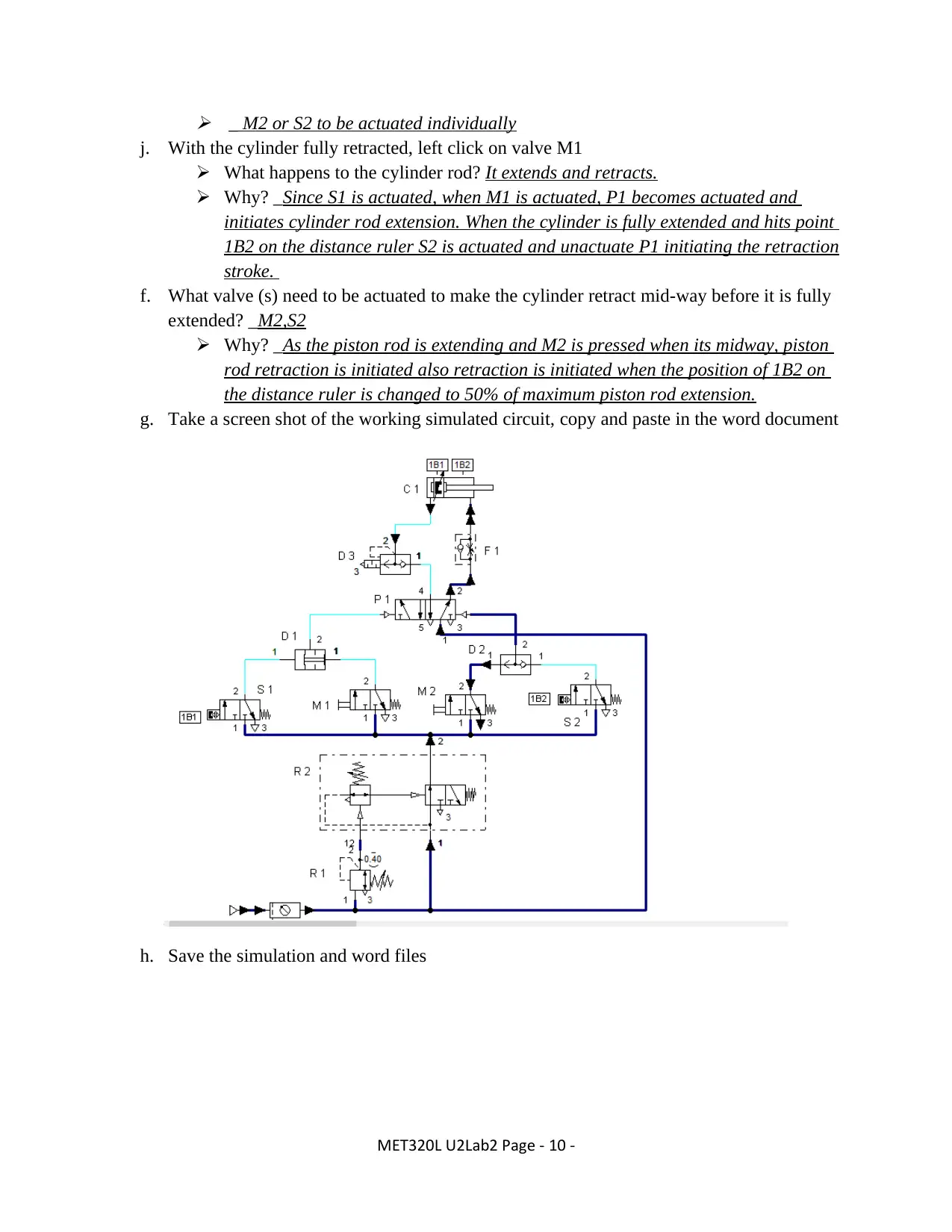
_ M2 or S2 to be actuated individually
j. With the cylinder fully retracted, left click on valve M1
What happens to the cylinder rod? It extends and retracts.
Why? _Since S1 is actuated, when M1 is actuated, P1 becomes actuated and
initiates cylinder rod extension. When the cylinder is fully extended and hits point
1B2 on the distance ruler S2 is actuated and unactuate P1 initiating the retraction
stroke.
f. What valve (s) need to be actuated to make the cylinder retract mid-way before it is fully
extended? _M2,S2
Why? _As the piston rod is extending and M2 is pressed when its midway, piston
rod retraction is initiated also retraction is initiated when the position of 1B2 on
the distance ruler is changed to 50% of maximum piston rod extension.
g. Take a screen shot of the working simulated circuit, copy and paste in the word document
h. Save the simulation and word files
MET320L U2Lab2 Page - 10 -
j. With the cylinder fully retracted, left click on valve M1
What happens to the cylinder rod? It extends and retracts.
Why? _Since S1 is actuated, when M1 is actuated, P1 becomes actuated and
initiates cylinder rod extension. When the cylinder is fully extended and hits point
1B2 on the distance ruler S2 is actuated and unactuate P1 initiating the retraction
stroke.
f. What valve (s) need to be actuated to make the cylinder retract mid-way before it is fully
extended? _M2,S2
Why? _As the piston rod is extending and M2 is pressed when its midway, piston
rod retraction is initiated also retraction is initiated when the position of 1B2 on
the distance ruler is changed to 50% of maximum piston rod extension.
g. Take a screen shot of the working simulated circuit, copy and paste in the word document
h. Save the simulation and word files
MET320L U2Lab2 Page - 10 -
Paraphrase This Document
Need a fresh take? Get an instant paraphrase of this document with our AI Paraphraser
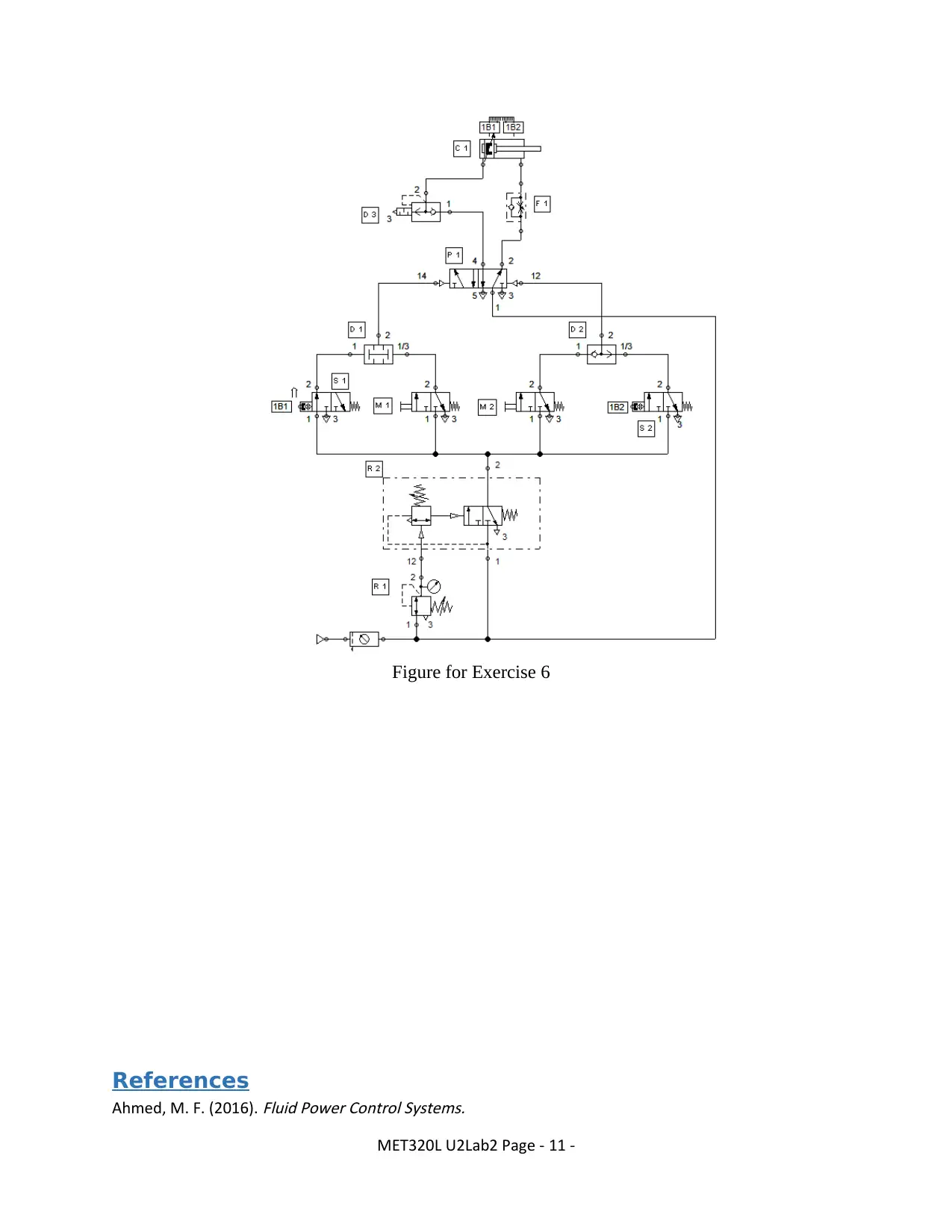
Figure for Exercise 6
References
Ahmed, M. F. (2016).
Fluid Power Control Systems.
MET320L U2Lab2 Page - 11 -
References
Ahmed, M. F. (2016).
Fluid Power Control Systems.
MET320L U2Lab2 Page - 11 -
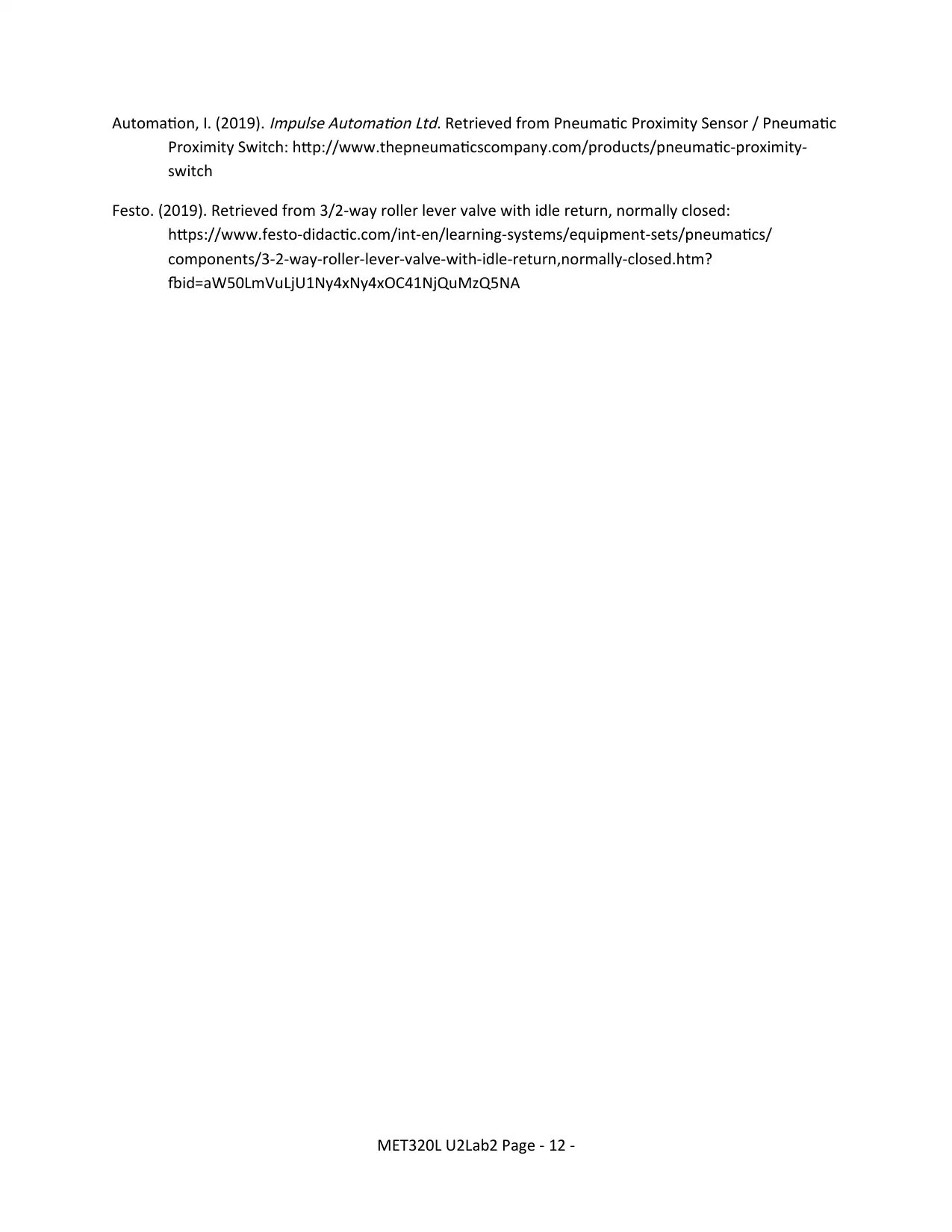
Automation, I. (2019).
Impulse Automation Ltd. Retrieved from Pneumatic Proximity Sensor / Pneumatic
Proximity Switch: http://www.thepneumaticscompany.com/products/pneumatic-proximity-
switch
Festo. (2019). Retrieved from 3/2-way roller lever valve with idle return, normally closed:
https://www.festo-didactic.com/int-en/learning-systems/equipment-sets/pneumatics/
components/3-2-way-roller-lever-valve-with-idle-return,normally-closed.htm?
fbid=aW50LmVuLjU1Ny4xNy4xOC41NjQuMzQ5NA
MET320L U2Lab2 Page - 12 -
Impulse Automation Ltd. Retrieved from Pneumatic Proximity Sensor / Pneumatic
Proximity Switch: http://www.thepneumaticscompany.com/products/pneumatic-proximity-
switch
Festo. (2019). Retrieved from 3/2-way roller lever valve with idle return, normally closed:
https://www.festo-didactic.com/int-en/learning-systems/equipment-sets/pneumatics/
components/3-2-way-roller-lever-valve-with-idle-return,normally-closed.htm?
fbid=aW50LmVuLjU1Ny4xNy4xOC41NjQuMzQ5NA
MET320L U2Lab2 Page - 12 -
⊘ This is a preview!⊘
Do you want full access?
Subscribe today to unlock all pages.

Trusted by 1+ million students worldwide
1 out of 12